
In today’s highly complex investment environment, investors value an attractive combination of higher yields, credit quality and liquidity. Against this backdrop, an ‘older’ segment of credit, whose time appears to have come again, is corporate subordinated debt, historically issued by large investment grade rated companies in the utilities, telecommunications, energy and property sectors.
Increased supply, beyond standard refinancing requirements, matched by renewed demand for these securities is tied to a unique set of factors explored below. As the demise of a significant segment of the domestic bank capital market approaches, we believe a selective approach to the subordinated corporate debt market holds appeal and can be a worthy addition to a diversified fixed interest portfolio.
Issuers’ attraction…
A major attraction for issuers of corporate subordinated debt is the receipt of partial “equity credit” from ratings agencies. This is helpful in supporting credit metrics and ratings profiles, particularly when undertaking a large investment phase or during a Merger and Acquisition (M&A) process, or when deleveraging has not occurred as quickly as originally anticipated. In addition to providing credit ratings support, the non-dilutive nature of this form of capital and tax deductibility of coupons are added benefits. For issuers, these securities are considered credit metric friendly debt / cheaper equity, and as such can be efficient from an overall cost of capital perspective.
…induces greater supply
On the supply side, the utility and energy sectors are experiencing a generational step-up in capital investment requirements to support both energy transition and artificial intelligence-driven growth in demand. Other essential infrastructure segments are also undergoing significant capital expenditure programs, an example being airports. Motivated by the aforementioned issuer attractions, corporate sub-ordinated debt has the potential to be an elegant intermediate capital solution.
Investors’ attraction…
Historically, higher yields relative to investment grade rated senior unsecured bond markets, and superior risk adjusted returns versus sub-investment grade bond markets, had seen investors favour the corporate subordinated debt asset class. However, investor caution had been linked to subordination and extension risks, and risks around ratings agency changes to methodology which had the potential to negatively impact the level of equity credit accorded to these instruments.
…motivates strong demand
Given an increasingly volatile geopolitical environment today, a renewed investor focus on both safety and yield is apparent. In this context, investors seeking higher yields are favoring stepping down the capital structure in higher quality investment grade issuers, as opposed to investing out the risk curve in pure sub-investment grade markets.
The latest iteration of corporate subordinated debt is increasingly rated investment grade (newer issuances are, on average, Baa3), comparing favourably to the BB/B dominated global high yield bond markets. Furthermore, instrument structures have incrementally improved from the perspective of creditors. Examples include limiting maximum extension risk (tenor of bonds capped at 30 years), and limiting discretionary deferability periods for coupons (limited to five years). In combination, these factors are mitigating previously held concerns.
Regulatory changes driving the phase out of the ASX listed bank capital market have motivated investors to seek alternative sources of yield. Private credit markets have offered a solution, albeit are seeing an increasing level of defaults and offer limited to no liquidity.
Finding opportunities in corporate subordinated debt
For those investors pursuing higher yields alongside a relative lower risk profile and some liquidity, an emerging sweet-spot is therefore corporate subordinated debt. The Australian corporate subordinated debt market has experienced strong growth recently, with well-known and highly regarded domestic companies such as Transgrid, Melbourne Airport and Scentre Group accessing the market to issue bonds. Global subordinated debt issuers like NextEra Energy have also undertaken Australian Dollar (AUD) issuance into strong demand, and we are anticipating more issuers to consider inaugural AUD issuance
Credit spreads on instruments callable in five years or longer, have been issued at >200 basis points (bps) above swap rates versus <200bps in the lower rated US HY BB rated bond market. Further, all in yields on occasion have the potential to sit above forward equity dividend yields, holding additional appeal to cross-asset investors in a slowing economic environment.
Active management is key
While the attractions for investors are numerous amidst renewed supply, an active approach to this segment is paramount. We continue to closely follow market developments including possible evolution in the structuring of these instruments. Of particular interest is whether elements like coupon floors, which provide increased certainty for investors around minimum yields should bonds be extended, make their way into instrument structures as they have started to do offshore.
With a 30-year track record investing across fixed interest and credit markets and with over A$23billion assets under management*, the Janus Henderson Australian Fixed Interest team has deep market and issuer relationships. This market standing places us in a strong position to support the growth of the domestic corporate subordinated debt market while ensuring we invest only when we believe our clients will be adequately compensated for risk.
Lastly, our global investment presence and deep credit expertise across US and European credit markets places us in an especially advantageous position to evaluate foreign issuers who intend to issue corporate subordinated debt in AUD.
We look forward to continuing to selectively support the growth in this market for the benefit of our investors.


























